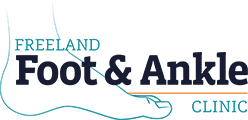Ice vs. Heat for Sports Injuries
Whether you've pulled a muscle, sprained your ankle, experience chronic pain, or even fractured a bone, your first instinct is probably to ice it. But is ice the best option for chronic and acute injuries?
Icing the injured area for 20 minutes at a time can help decrease pain and swelling. Ice is best for acute injuries or flare-ups of chronic problems. Heat is most useful for chronic pain and stiffness. A good rule of thumb: always ice, sometimes heat.
Let's dive into the specifics on ice vs. heat and learn plenty of helpful information on what to do immediately following an injury right from a foot and ankle doctor specializing in sports injuries.
![Close-up Of A Woman's Hand Applying Ice Gel Pack On Her Ankle]() When Should You Use Ice on an Injury?
When Should You Use Ice on an Injury?
Imagine you're on a run or working out at the gym and you twist your ankle. You get right back up, but the pain doesn't go away. Maybe you power through the rest of your workout, or perhaps you take the rest of the day off. Either way, you'll probably notice some swelling, redness, and pain.
When you sustain an injury, especially a foot or ankle injury, the first thing you should do is employ the steps of R.I.C.E. therapy.
What is R.I.C.E. therapy?
This handy pneumonic stands for:
Rest
Ice
Compression
Elevation
So get off your feet, grab an ice pack and an ace bandage or compression socks, and elevate the injured area. Following these steps will help to decrease inflammation and pain. In a previous article, I discuss
![a close up of a woman holding her heel because there is pain radiating from it]() Do's and Don't's of Icing an Injury
Do's and Don't's of Icing an Injury
Do:
- Ice the area immediately following your workout or right after sustaining the injury
- Ice for the right amount of time: about 20 minutes
- Wrap your ice pack with a towel or old t-shirt to avoid tissue damage, skin irritation, and even frostbite (That's right: using ice incorrectly can cause frostbite, so be careful)
- Ice 3-5 times a day
- Contact a doctor if your symptoms don't improve or worsen
Don't:
- Ice before exercising as this causes muscle contraction and can lead to increased pain and a worsening of your symptoms in general
- Use the ice for too long because, as stated above, icing improperly can lead to tissue damage, skin irritation, and even frostbite
Again, if R.I.C.E. therapy alone does not help improve your symptoms, prolonging that dreaded call to the doctor's office will only lead to more problems and even permanent damage, depending on the injury. Head to an urgent care or specialist and get an x-ray as soon as you can to rule out a fracture.
When Should You Use Heat on an Injury?![Treatment of arthritis of the ankle joint with a heating pad with hot water.]()
I like to give my patients this advice: always ice, sometimes heat.
It's an easy enough thing to remember, but knowing when to use heat on an injury isn't quite so easy.
According to this article from Piedmont Healthcare, utilizing heat opens smaller blood vessels. This can have the complete opposite effect of ice, meaning you could actually end up with more inflammation instead of decreasing it.
"Heat treatments should be used for chronic conditions to help relax and loosen tissues, and to stimulate blood flow to the area," the article says. You can use heat to treat conditions like arthritis or old injuries when they flare up due to exertion or barometric pressure.
How to Use Heat to Treat Pain
Here are some tips to help you get the most out of heat therapy for chronic pain:
- How long should you use heat to treat pain? In general, the same 20-minute method used for icing applies to heat. It's important to listen to your body and remove the hot compress or heating pad if you feel surface-level discomfort from the heat.
- Can you sleep with a heating pad? Never, under any circumstances, fall asleep with a heating pad. Most modern heating pads, like this DailyLife Heating Pad with auto shut-off from Amazon, come with a feature that shuts the device off after a few hours. Even so, using heating pads for too long can cause severe burns, blisters, and pain.
- When should you use heat? For chronic pain from arthritis, plantar fasciitis, or old injuries, use heat as needed to decrease pain.
- How can you use heat therapy at home without a heating pad? Some other options for heat therapy include a steaming hot shower, a nice soak in a hot bath, a towel soaked in hot water, or a DIY microwavable hot pack.
What Else Can You Do Instead of Ice or Heat?
Another option for pain associated with sports injuries or chronic conditions is laser pain therapy. Laser therapy is an advanced treatment that offers almost-immediate relief of your pain. By stimulating the area causing you pain with heat from the laser, your body's natural healing processes are sent into action to heal the injury, decrease pain, and get you better, faster.
Laser pain therapy is offered by many health care providers and sports medicine facilities, including Freeland Foot and Ankle Clinic. Check out our past article and learn how to use laser therapy to accelerate healing.
 Additionally, topical pain-relief products are available to help maintain a normal life while you wait to fully recover from your injury. Those experiencing chronic pain can also find relief with topical pain relief. By using analgesic ingredients like menthol, pain can be put on the back burner for a while. Your life doesn't stop when you get injured or if you have chronic pain, and topical pain relief can help you get by. I recommend Biofreeze Professional Pain Relief Gel, which is why it's always available for purchase in my office. With a higher concentration of its analgesic ingredients than other products on the market, this easy-to-use gel can be applied as needed to relieve pain.
Additionally, topical pain-relief products are available to help maintain a normal life while you wait to fully recover from your injury. Those experiencing chronic pain can also find relief with topical pain relief. By using analgesic ingredients like menthol, pain can be put on the back burner for a while. Your life doesn't stop when you get injured or if you have chronic pain, and topical pain relief can help you get by. I recommend Biofreeze Professional Pain Relief Gel, which is why it's always available for purchase in my office. With a higher concentration of its analgesic ingredients than other products on the market, this easy-to-use gel can be applied as needed to relieve pain.
Finally, kinesiology taping is another great addition to your bag of pain-relief tricks, especially if you experience chronic pain that keeps you from being as active as you'd like to be. Studies show that kinesiology tape, also called K-Tape, can help to increase your range of motion, lessen muscle fatigue, and decrease inflammation.
What if Treating an Injury at Home Doesn't Help?
Icing, using heat, and employing the R.I.C.E. therapy methods might not be enough to get rid of your pain. If the pain persists, you must contact a healthcare professional to avoid permanent damage and prolonged healing.
For fast healing with little to no downtime, Freeland Foot and Ankle Clinic, conveniently and centrally located less than half an hour from Saginaw, Midland, and Bay City, has you covered. With our toolbox of state-of-the-art advanced treatments like laser therapy and EPAT, we will get you back on your feet in no time. The best part? We won't make you wait a month to be seen. Same-day appointments are available now, so give us a call or text us at 989-695-6788, and don't live with foot or ankle pain for another moment.

 When Should You Use Ice on an Injury?
When Should You Use Ice on an Injury? Do's and Don't's of Icing an Injury
Do's and Don't's of Icing an Injury
